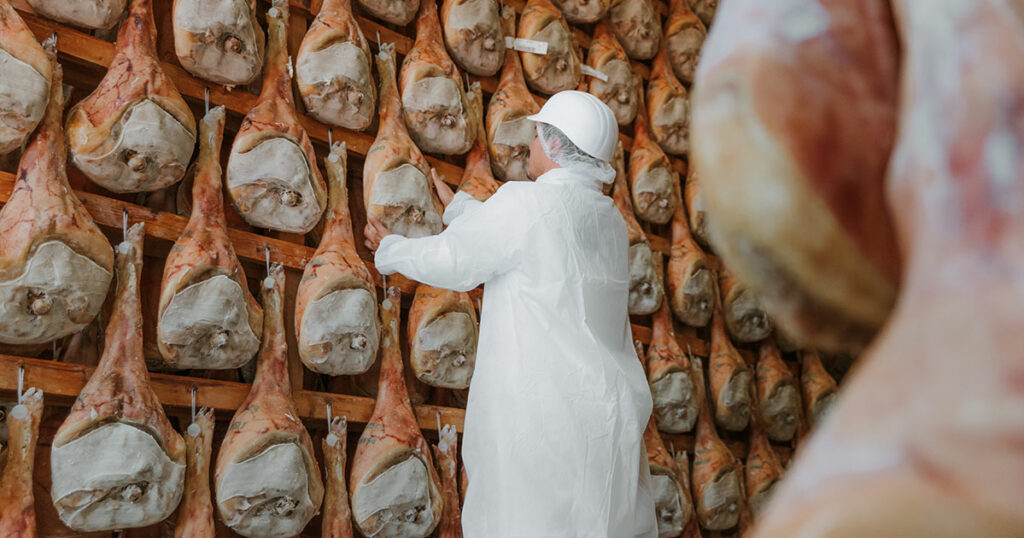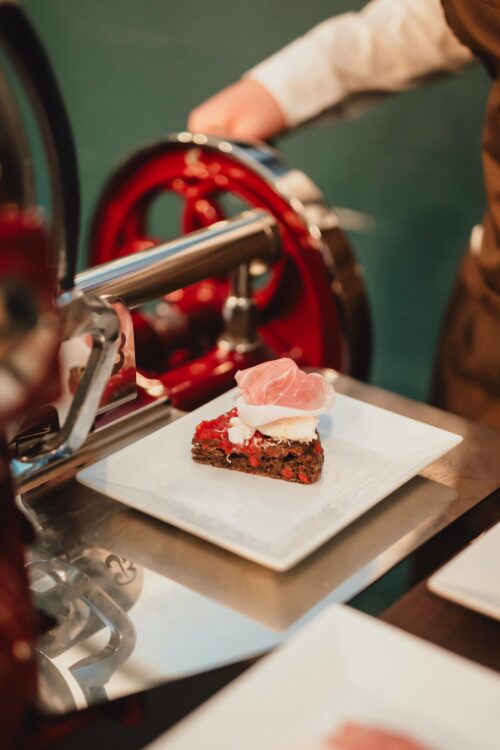Taste, flavour and history: Prosciutto di San Daniele is the result of a centuries-old tradition rooted in a process which remains unchanged over time. Over the centuries, this art has evolved thanks to the advent of technology, which has allowed the production process to be improved, making it safer and more efficient.
But how did we arrive at this culinary delicacy?
A unique environment
The secret to Prosciutto di San Daniele lies mainly in its production environment. The town of San Daniele del Friuli boasts a unique microclimate, the culmination of the warm currents rising from the Adriatic Sea meeting the cool, dry currents from the Carnic Alps. Furthermore, the Tagliamento river, with its crystal-clear waters, acts as a natural thermoregulator, keeping the humidity and temperature of the air constant. This combination of climatic factors creates the unique conditions for ageing the pork thighs.
Sea salt, carefully selected pork legs and the San Daniele del Friuli air: these are the only ingredients allowed in the production of San Daniele PDO. Each slice tells a story of tradition, passion and is, above all, an expression of the territory from which it was born.
The Product Specification stipulates that Prosciutto di San Daniele may only be produced within the Municipality of San Daniele del Friuli. The required regulations are strictly observed in the Consortium’s thirty-one prosciutto factories, guaranteeing quality and safety for consumers.
Prosciutto di San Daniele production, a certified and controlled process
San Daniele PDO is a high quality product that reflects the values of a controlled supply chain in every aspect. The Prosciutto di San Daniele production process starts with the arrival of the legs at the prosciutto factories, which must come from pigs born and bred in certified farms in the ten regions of Central and Northern Italy, as stipulated within the pages of the Specification.
The legs must be transferred to the prosciutto factories within five days of slaughter, weigh between 12.5 and 17.5 kg and have a good ratio between the lean mass and the layer of fat. As soon as they arrive at the prosciutto factory, the thighs are subjected to a preliminary conformity check.
Compliant legs are stamped with the processing start date, which also makes it possible to calculate the ageing duration. They are then transferred to cold rooms so that the meat can settle to a temperature of around 0 °C, an essential process to prepare them for the subsequent processing steps.
Then comes the trimming, where excess fat and muscle are removed from the inner thigh. Salting is the next step: the legs are covered with salt and laid on a flat surface, before being placed in cold rooms for a number of days equal to their weight in kilograms, so as to ensure they are salted evenly.
After the salting phase, the prosciutto undergoes pressing, where the legs are arranged one on top of the other to promote uniform distribution of the salt and stimulate the loss of internal fluids. It is thanks to this process that the prosciutto takes on the classic guitar shape.
Afterwards, the legs rest in special humidity- and temperature-controlled rooms for around four months so as to ensure uniformity and that the thighs are fully aged.
After this phase, the thighs are washed with warm water and then dried under temperature-controlled conditions, for a perfect drying.
After washing and drying, the legs are placed in designated ageing rooms. During this period, the ‘sugna’, a paste of rice flour and pork fat, is applied to the part of the leg covered in the rind, which is used to prevent the meat from excessively drying out without interrupting the ageing process.
The legs stay for a minimum of 400 days in these spaces that are equipped with ample windows, allowing the winds of San Daniele to softly caress the meat. In fact, the unique air of this place is the secret to bestowing Prosciutto di San Daniele PDO with its unmistakable flavour.
In the last phases in the production of San Daniele PDO, piercing and branding the legs play a key role. The piercing is an essential check to monitor the ageing process: a bone, taken from a horse’s femur, is inserted into the thigh to assess the aromas and texture.
After 400 days of ageing have elapsed and the rigorous checks by the IFCQ Certificazione body have been passed, only the legs that meet all the Product Specification requirements receive certification and are branded with the Consortium’s logo. Only from this moment on, to all intents and purposes, can we speak of Prosciutto di San Daniele.






